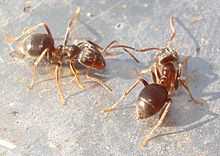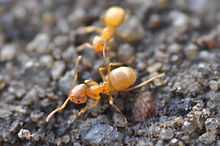Lasius
| Lasius | |
|---|---|
 | |
| Lasius sp. from Germany | |
| Scientific classification | |
| Kingdom: | Animalia |
| Phylum: | Arthropoda |
| Class: | Insecta |
| Order: | Hymenoptera |
| Suborder: | Apocrita |
| Superfamily: | Vespoidea |
| Family: | Formicidae |
| Subfamily: | Formicinae |
| Tribe: | Lasiini |
| Genus: | Lasius Fabricius, 1804 |
| Species | |
|
very many, see text | |
Lasius is a genus of formicine ants.[1] The type species for this genus is the black garden ant, Lasius niger. Other major members, which live in drier heathland, are the cornfield ant, L. neoniger, and L. alienus
Other species include the temporary social parasites of the L. mixtus group and the hyper-social parasite Lasius fuliginosus.
Lasius flavus is also a commonly seen species, building grassy hillocks in undisturbed pasture. In the Alps, these mounds - always aligned east to catch the first rays of the rising sun - have been traditionally used by goatherds as natural compasses.
The genus was renamed by Horace St. John Kelly Donisthorpe, the eccentric British myrmecologist and coleopterist, after himself Donisthorpea.
Synonyms: Donisthorpea Donisthorpe
Moisture ants
Many Lasius species, known collectively as "moisture ants" in the United States, make their nests in and around moist rotting wood as well as under rocks.[2][3] They can infest buildings, particularly foundation forms in contact with soil, becoming a minor nuisance.[4][2] They are not considered a structural threat because they only make their galleries in wood that is already decayed.[4] Some species build "cartonlike" nests in moist locations made of decayed wood fragments cemented together with honeydew and the ant's mandibular gland secretions.[3] Workers are monomorphic, 2 to 3 mm long, yellow to dark brown.[2] They are secretive, and forage mostly at night for honeydew and other sweet substances, and may also prey on small insects.[2] Winged reproductive males and females swarm in late summer and fall, which is when building infestations may be noticed.[2] They are distinguished from carpenter ants (Camponotus), another structure-infesting species, by being much smaller, and having a notch in the dorsal thorax (top of the center body division), where carpenter ants have a rounded thorax.[4][2] Widespread moisture ant species include L. alieni and L. neoniger, as well as some Acanthomyops species.[3]
Species



- Lasius alienoflavus Bingham, 1903
- L. alienus (Foerster, 1850)
- L. atopus Cole, 1958
- L. austriacus Schlick-Steiner, Steiner, Schödl & Seifert, 2003
- L. balcanicus Seifert, 1988
- L. bicornis (Foerster, 1850)
- L. breviscapus Seifert, 1992
- L. brunneus (Latreille, 1798)
- L. brunneus brunneus (Latreille, 1798)
- L. brunneus emarginatobrunneus Ruzsky, 1902
- L. buccatus Staercke, 1942
- L. capitatus (Kuznetsov-Ugamsky, 1927)
- L. carniolicus Mayr, 1861
- L. chambonensis Theobald, 1935
- L. cinereus Seifert, 1992
- L. citrinus Emery, 1922
- L. coloratus Santschi, 1937
- L. crinitus (Smith, 1858)
- L. crispus Theobald, 1935
- L. crypticus Wilson, 1955
- L. distinguendus (Emery, 1916)
- L. draco Collingwood, 1982
- L. emarginatus (Olivier, 1792)
- L. epicentrus Theobald, 1937
- L. escamole Reza, 1925
- L. exulans Fabricius, 1804
- L. fallax Wilson, 1955
- L. flavescens Forel, 1904
- L. flavoniger Seifert, 1992
- L. flavus (Fabricius, 1782)
- L. fuliginosus (Latreille, 1798)
- L. gebaueri Seifert, 1992
- L. globularis (Heer, 1850)
- L. grandis Forel, 1909
- L. hayashi Yamauchi & Hayashida, 1970
- L. hikosanus Yamauchi, 1979
- L. himalayanus Bingham, 1903
- L. hirsutus Seifert, 1992
- L. humilis Wheeler, 1917
- L. japonicus Santschi, 1941
- L. jensi Seifert, 1982
- L. jensi jensi Seifert, 1982
- L. jensi longiceps Seifert, 1988
- L. karpinisi Seifert, 1992
- L. koreanus Seifert, 1992
- L. lasioides (Emery, 1869)
- L. lawarai Seifert, 1992
- L. longaevus (Heer, 1850)
- L. longipennis (Heer, 1850)
- L. magnus Seifert, 1992
- L. meridionalis (Bondroit, 1920)
- L. mikir Collingwood, 1982
- L. minutulus (Heer, 1850)
- L. minutus Emery, 1893
- L. mixtus (Nylander, 1846)
- L. monticola (Buckley, 1866)
- L. morisitai Yamauchi, 1979
- L. myops Forel, 1894
- L. nearcticus Wheeler, 1906
- L. neglectus Van Loon, Boomsma en Andrasfalvy, 1990
- L. nemorivagus Wheeler, 1915
- L. neoniger Emery, 1893
- L. nevadensis Cole, 1956
- L. niger (Linnaeus, 1758)
- L. niger niger (Linnaeus, 1758)
- L. niger pinetorum Ruzsky, 1907
- L. nigrescens Stitz, 1930
- L. obliteratus (Heer, 1850)
- L. oblongus Assmann, 1870
- L. obscuratus Stitz, 1930
- L. obscurus (Heer, 1850)
- L. occultatus (Heer, 1850)
- L. occultatus occultatus (Heer, 1850)
- L. occultatus parschlugianus (Heer, 1850)
- L. pallitarsis (Provancher, 1881)
- L. paralienus Seifert, 1992
- L. peritulus (Cockerell, 1927)
- L. piliferus Seifert, 1992
- L. platythorax Seifert, 1991
- L. productus Wilson, 1955
- L. przewalskii Ruzsky, 1915
- L. psammophilus Seifert, 1992
- L. pumilus Mayr, 1868
- L. rabaudi (Bondroit, 1917)
- L. redtenbacheri (Heer, 1850)
- L. redtenbacheri neuter (Heer, 1850)
- L. redtenbacheri redtenbacheri (Heer, 1850)
- L. reginae Faber, 1967
- L. rubiginosus (Latreille, 1802)
- L. sabularum (Bondroit, 1918)
- L. sakagamii Yamauchi & Hayashida, 1970
- L. schaeferi Seifert, 1992
- L. schiefferdeckeri Mayr, 1868
- L. schulzi Seifert, 1992
- L. sitiens Wilson, 1955
- L. sonobei Yamauchi, 1979
- L. spathepus Wheeler, 1910
- L. speculiventris Emery, 1893
- L. subumbratus Viereck, 1903
- L. talpa Wilson, 1955
- L. tebessae Seifert, 1992
- L. teranishii Wheeler, 1928
- L. terreus Scudder, 1878
- L. tertiarius Zalessky, 1949
- L. turcicus Santschi, 1921
- L. umbratus (Nylander, 1846)
- L. uzbeki Seifert, 1992
- L. vestitus Wheeler, 1910
- L. vetulus Dlussky, 1981
- L. viehmeyeri Emery, 1922
- L. wittmeri Seifert, 1992
- L. xerophilus MacKay & MacKay, 1994
References
- ↑ "Genus: Lasius". AntWeb. Retrieved 02-05-12.
- ↑ 2.0 2.1 2.2 2.3 2.4 2.5 Klotz, John H. (2010). Urban Pest Management of Ants in California. UCANR Publications, Division of Agriculture and Natural Resources, University of California. pp. 54–55. ISBN 1601076649.
- ↑ 3.0 3.1 3.2 Klotz, John H. (2008). Urban Ants of North America and Europe: Identification, Biology, and Management. Cornell University Press. pp. 39–44. ISBN 0801474736.
- ↑ 4.0 4.1 4.2 Antonelli, Art (2007). "Extension Bulletin 1382: Moisture Ants". WSU Extension. Washington State University. Retrieved March 4, 2013.
External links
| Wikimedia Commons has media related to Lasius. |
- Online Catalog of Ants of North America: Genus Lasius (with distribution, sketches and pictures)
- Fabricius, J. C. 1804. Systema Piezatorum. Carolum Reichard, Brunsviga (Original description, in Latin; PDF 2.5M)
- Citronella Ants